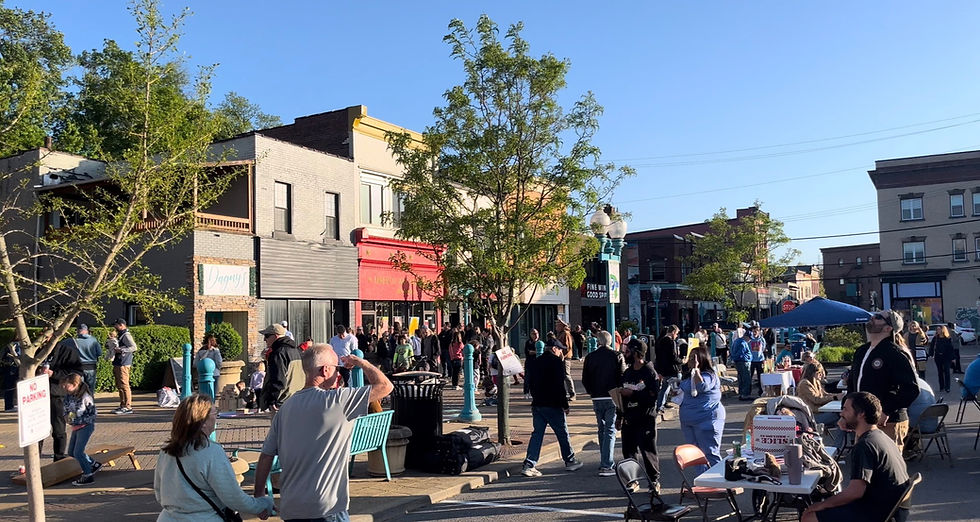Pets Becoming Welcome Part of Senior Living Communities
- Vanessa Orr
- Nov 30, 2022
- 4 min read

For many people, pets are a part of the family, so it can be a very difficult decision to move into an independent or retirement living community if they aren’t able to take their furry friends along. Fortunately, a number of these communities offer residents the chance to move in with their pets, benefitting not only the pets’ owners, but the community as a whole.
“Pets are good for our residents; mind, body and soul,” said Vincentian Independent Living Property Manager Melia Black. “Not only is a pet a companion, but they also provide a reason to get up and get out and walk, which contributes to overall physical and mental wellness.
“Whenever you have a pet, people also engage with you,” she added. “Neighbors stop and talk to you because you have that icebreaker.”
According to Christine Holko, director, Independent Living, Community Engagement & Sales for Vincentian, pets are allowed at both Terrace Place and Vincentia Villa, which are independent living communities, and Vincentian Schenley Gardens in Oakland, which provides personal care.

“People who have to go to a higher level of care shouldn’t be penalized just because they need more assistance,” she said of Vincentian’s decision to allow pets. Residents are allowed up to two pets with a total 40 pound weight limit, including dogs, cats and other animals by approval.
“Our current furry friends are all cats and dogs, except for one little fish in a fish bowl,” she said. Residents are required to keep veterinary care up-to-date and pay a one-time, nonrefundable fee of $500, which is used in part for a deep clean of the residence before new tenants move in.
Approximately 10 percent of the residents at Terrace Place have pets, and Holko says potential residents ask about the pet policy before choosing where to live.
“There is definitely a demand for residences where people can have their pets, and it is something we advertise and why some people choose us,” she said. “They see these animals as a part of their families.”
The pets are also ‘adopted’ into the community as well and bring joy to the other residents, said Holko.
“All of our residents enjoy seeing the pets out and about; it creates an overall sense of happiness and delight, quite frankly, when animals are around and people can interact with them.
“Our staff is also very furry-friendly and love to see them,” she added. “It’s one of the best parts of our job to get some doggie snuggles.”
Vincentian is also open to other ways of incorporating pets into the community, and have had miniature ponies and therapy dogs come visit and interact with the residents. “People come who are interested in seeing them; even those who are more introverted or private come out to engage,” said Holko.

All of Concordia Lutheran Ministries’ retirement communities are pet-friendly, including Highpointe at Rebecca on the Concordia at Rebecca Residence campus in Allison Park, and the Concordia Haven Apartments on the Concordia at Cabot campus in Cabot, PA, as well as its communities in Pittsburgh’s South Hills and those in Florida and Ohio.
“The bottom line is that there are a lot of benefits to seniors having pets in the retirement community setting,” said Frank Skrip, director of Public Relations, Concordia Lutheran Ministries. “There are the physical benefits that come from walking a dog or playing with a dog or cat, but they also help with feelings of isolation or loneliness, and they provide comfort to individuals in need of companionship.
“Pets also help to create connections with other people,” he continued. “We’ve seen them help residents build social networks in our retirement communities.
“Talking about dogs is a great icebreaker with other dog owners, and we’ve also seen some very unofficial dog walking groups form in our communities,” he added. “Residents bring their dogs out to play at the same times of day. It provides another opportunity for socialization in the retirement community.”
Approximately 10-15 percent of Concordia’s retirement living residents are pet owners; for example, at Highpoint at Rebecca, 15 of the 109 apartment owners have pets.
“Cats and dogs are the big ones, but birds, fish, and other small animals are permitted at Concordia locations, as long as they are not disruptive to other residents,” said Skrip.
While rules at each facility vary slightly, at Highpointe at Rebecca, each apartment can have one dog, 25 pounds or less, and the animal must be spayed or neutered, licensed, up-to-date on shots, house-trained and obedient. Residents are also allowed up to two cats.
“We also encourage individuals who want dogs specifically to get ground-floor apartments with walk-out patios, which is more conducive for the pet to get outside quickly if need be,” said Skrip.
The residence charges an $1,800 nonrefundable pet fee per apartment, which goes toward the additional cost of cleaning and replacing carpet when the resident leaves the apartment.
Concordia has also seen an increase in the number of people wanting to bring their pets and has responded to meet the needs of the changing market.
“If someone has a pet, they absolutely ask us about bringing it,” Skrip said. “I can remember several years ago when this was a more divisive topic within retirement communities, but like so many other industries, we have become more customer- and resident-focused, which means providing them with the amenities they require.
“As my boss says, ‘When you try to give too many rules to 80-year-olds, you go out of business pretty quickly,” he laughed. “And when we realized that this is what modern residents wanted, we decided that allowing pets, who they consider to be their family members, was what we needed to be doing.”


























Comments